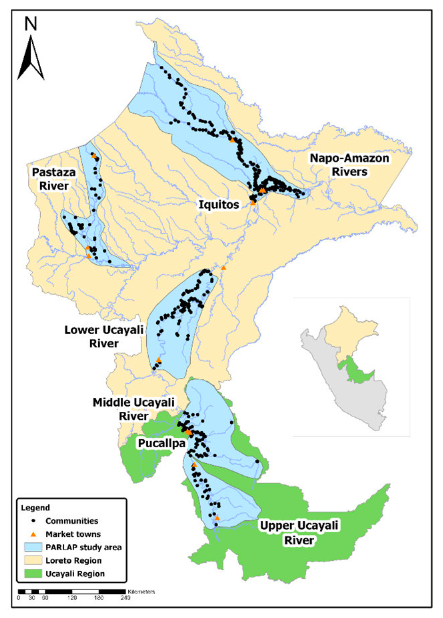RECOVR Roundup Vol. 14: Social Protection in the Time of COVID-19
In this fourteenth installment of our RECOVR Roundup series, we are sharing new findings and analysis from the RECOVR Research Hub and from our partner organizations, as well as links on what is happening in the Social Protection landscape in response to COVID-19. Read the previous installment if you missed it, and sign up for our mailing list if you'd like to receive this roundup series directly to your inbox.
As always, we encourage you to write to our team with ideas for features.
 New Findings & Analysis
New Findings & Analysis
Peru: In the Amazon, detailed data reveal new patterns of COVID-19’s impacts
A majority of respondents maintained most preventive measures, but perceptions of the country’s management of COVID-19 shifted over time

COVID-19 cases reached remote communities in the Peruvian Amazon last year, but the government's efforts to collect data about the pandemic were more focused on cities, leaving the impact of the pandemic in rural areas unclear. Yoshito Takasaki, Christian Abizaid, and Oliver Coomes addressed this gap by surveying 470 indigenous and non-indigenous communities in the region. Their latest findings point to different patterns than what had been publicly reported, including mortality rates that were higher where government data had reported it lower, and that non-indigenous communities were hit harder than indigenous ones, despite media reports of the opposite. While some protection measures were adopted, they found school closures incomplete and distancing low, which may have contributed to a second wave. There was virtually no access to health assistance, and while government benefits were received, it required travel to cities to collect, which may have contributed to the spread. To sustain themselves, people turned more to hunting, fishing, and timber collecting, which may have also increased strain on natural resources.
Visit the study summary here to learn more about the findings.
Kenya: Can technology help buffer 8th graders against school disruptions?
Educational technology has to be accessible to be usable
CEGA explains on their blog how Kenya sought to mitigate this ‘lost year’ of education with a variety of technological ways for kids to keep learning. Researchers Stephanie Bonds, Anya Marchenko, Carolyne Nekesa, Connie Otwani, John Kudoyi, and Noah Mambo surveyed nearly 3,000 8th grade students and their parents from 198 schools in Busia County. Almost all reported students spending some time studying in the past week (2.2 hrs/day), though far less than they normally would in school. Twenty percent reported attending in-person private lessons, and most (67 percent) students used some of the technology resources, primarily broadcast. Internet resources were used by only a small number of students, however, as most households didn’t own a smartphone, tablet, or computer. Read more about this study.
Rwanda and Zambia: How have residents fared over time as the COVID crisis continued, and how should policymakers respond?
Economic and social programs must continue to cushion against shocks, while laying the foundation for long-term recovery
On the IPA blog, we recap a recent webinar and key findings from the second round of IPA’s RECOVR surveys in Zambia and Rwanda. In both countries, there were pockets of progress with continued adherence to certain virus mitigation measures and high acceptance rates for vaccinations. Education remained a key concern for parents of learners, with the prospect of potential learning losses. At the same time, as the pandemic continues, challenges remain with respect to food security and long-term economic damage on livelihoods. We discuss strategies for addressing anticipated learning losses in schools, behavior change and communications strategies to promote follow-through with intentions to vaccinate, and considerations for policymakers to expand social protection measures.
Read the Rwanda blog here and the Zambia blog here.
 What We're Reading & Watching
What We're Reading & Watching
- As countries debate the amount and duration of pandemic-era social assistance, here's a useful reminder from Bolivia suggesting cash transfers don't discourage work. Research from the IADB carried out before the pandemic found that the mothers of children who were eligible for a conditional cash transfer were more likely to start their own small businesses, and spent more time working each week.
- Access to quality childcare is one of the key types of support that parents need in order to keep working after they have children. However, the World Bank estimates that almost 40 percent of the world’s children under age six need childcare but don’t have access to it. Providing it would have big multipliers—expanding the workforce to both parents, potentially giving children a safe and healthy learning environment, and providing a new source of jobs for the providers.
- In Vancouver, a recent study showed that unhoused (homeless) people who received an unconditional cash grant of CA$7500 were much more likely to find housing, and spent more money on rent and less on drugs and alcohol, compared to peers who didn’t receive the funding. The program was small, just 50 people in the treatment group, but the researchers found the grants paid for themselves, in the form of reduced government spending on social services and policing. This Vox article also discusses the research and findings.
- Are social safety nets reaching the most vulnerable people in African countries? A report from the Centre for the Study of the Economies of Africa shows that more than 80 percent of people living in poverty in Nigeria and Uganda do not receive any government benefits, pointing to significant limitations in the scale of welfare provision.
- Strong national identification systems can help governments identify people in need of support during economic crises and deliver the help they might need, but 23 countries around the world still don’t have comprehensive ID systems. The Philippines is currently running an ambitious program to provide digital IDs to the majority of the population by the end of 2022.












